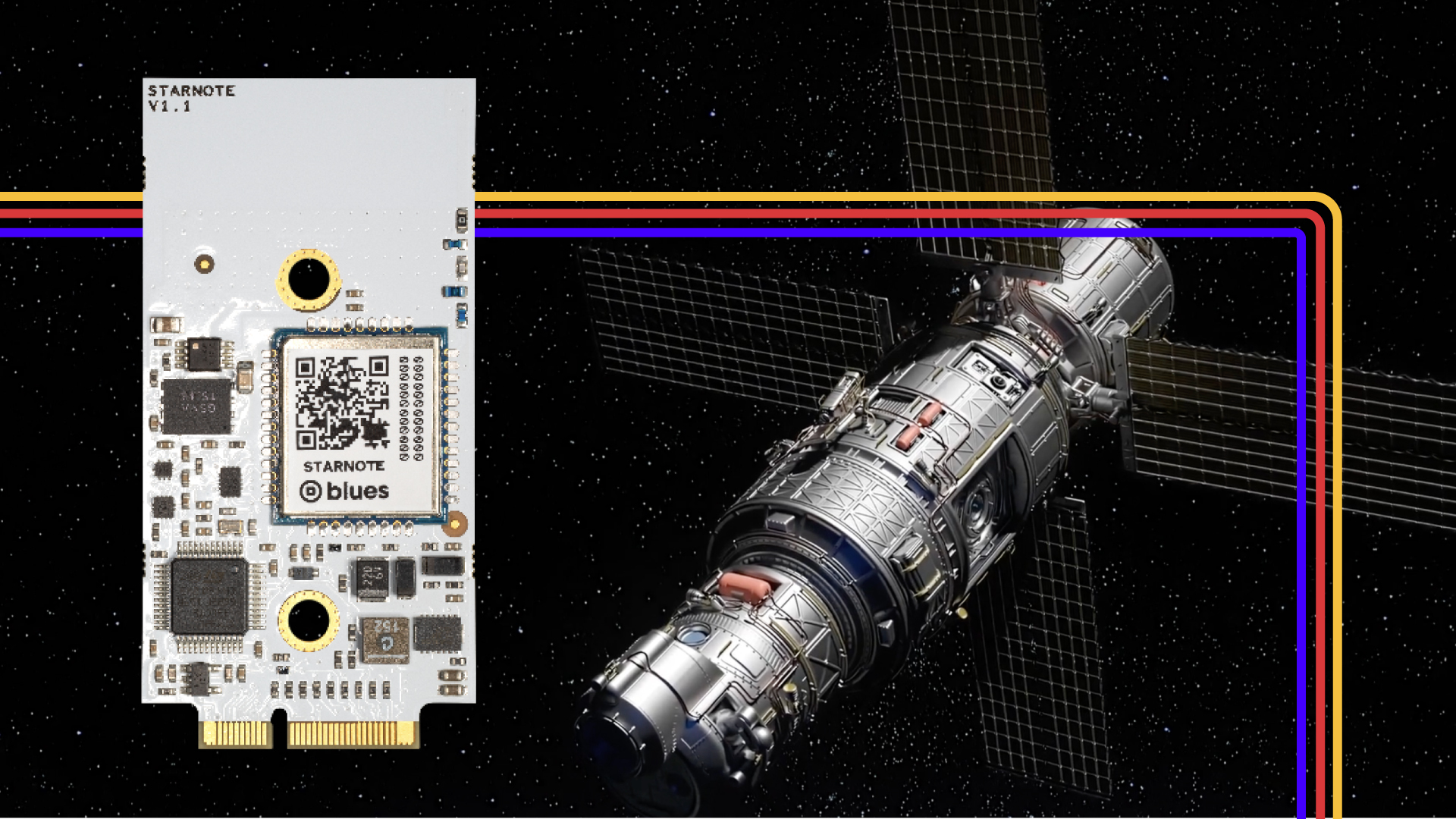Communication technology continues to have an impact across industries, and the development of satellite IoT is no different. Satellite connectivity transcends network limitations, offering unparalleled opportunities in the most distant and challenging environments.
Leveraging satellite networks ensures that devices, from remote sensors to mobile messaging to trackers, are never without coverage or connectivity.
Blues’ Starnote for Skylo enables device manufacturers to connect to satellite networks using the existing Notecard ecosystem. It represents a blend of cutting-edge technology and user-centric design poised to redefine the boundaries of Satellite connectivity.

Starnote features
Starnote is designed to work in conjunction with a Blues Notecard for cellular or Wi-Fi, adding redundancy to your device so that you will always be online if your primary connectivity solution fails. This flexibility ensures robust and uninterrupted connectivity to cater to diverse requirements across terrains and applications.
Here are some key advantages that businesses experience when integrating Starnote into their operations:
- Advanced connectivity: Starnote combines LEO satellite backup connectivity with the ease and familiarity of cellular and Wi-Fi networks. This integration expands the coverage range and ensures reliable communication in remote locations.
- Easy to use: Starnote maintains a JSON-based programming interface consistent with Blues’ Notecard solution. This feature ensures ease of use for developers, allowing them to access another major Radio Access Technology with a plug-and-play module.
- Rapid integration: Starnote’s interface streamlines the development process, significantly reducing integration time. Its compatibility with familiar programming paradigms allows developers to quickly incorporate Satellite capabilities into their projects without the steep learning curve often associated with satellite technology integration.
- Alignment with device lifecycles: Understanding the misalignment of costs with device lifecycles, Starnote offers a more practical financial model. It avoids the burden of continuous monthly costs for devices, which is particularly beneficial for devices that are not always “active.”
- Inclusive of satellite uplink and downlink data: The cost of the Starnote device includes both satellite uplink and downlink data. This bundling is crucial to its cost-effectiveness, simplifying the pricing model and making it more predictable for users.
Starnote simplifies and expands the accessibility of satellite IoT applications. By offering a versatile, user-friendly, and affordable device, the promise of global connectivity becomes a reality, allowing our customers to keep their devices connected.

Real world applications
There is no limit to what you can build with Starnote for Skylo, but here are a few industries suited to satellite connectivity for improved efficiency, cost savings, and operational capabilities.
- Marine telematics: Starnote for Skylo’s satellite connectivity ensures uninterrupted communication for vessel tracking and emergency services in maritime operations. This enhances safety and operational efficiency, especially in remote near shore areas which traditionally suffer from unreliable communication methods.
- Smart agriculture: In agriculture, Starnote’s real-time data capabilities enable precision farming even in remote locations. Farmers can optimize resource use, increase crop yields, and reduce environmental impact through efficient data-driven decision-making.
- Mining and construction: Starnote provides robust connectivity in remote mining and construction sites by supporting critical functions like equipment tracking, predictive maintenance, and emergency alerts.
- Transportation: Starnote offers reliable tracking and monitoring of vehicles and cargo for logistics and supply chain management, ensuring efficient operations and enhanced supply chain visibility.
How does the Starnote’s features translate into tangible business impact for device manufacturers:
- Enhanced efficiency: Starnote’s reliable connectivity and data capabilities improve operational efficiency, such as more precise resource allocation in agriculture or smoother and safer navigation and tracking in the maritime industry.
- Cost savings: Starnote is available for $49, offering improved connectivity at a much lower cost per device compared to other options on the market, which can cost $200-300. Each device comes with 18KB of data and once this is used up, additional data costs $0.75 per KB. There are no monthly subscriptions or minimum usage costs, so you only pay for the data you use, when you use it.
- Operational capabilities: Expanding the developer-accessible programming model – used by the Notecard for Cellular, Wi-Fi, and LoRa – into the satellite domain simplifies the integration process. It allows industries to adopt Satellite without requiring extensive technical expertise.

How Starnote compares to competing solutions
Blues’ Starnote offers a blend of features, affordability, and accessibility that sets it apart from its competitors.
Comparing features and pricing
- Starlink direct-to-cell: Will be introduced for the IoT industry in 2025
- Swarm (acquired by SpaceX): Previously sold its hardware device for $119, with a monthly fee of $5 for up to 750 packets of 200 bytes each.
- Iridium: Offers an Edge Pro Development Kit for $999, which includes hardware and free airtime for six months. Monthly service starts at $31.50 with no included data.
- Sateliot: Provides an NTN extension to terrestrial coverage.
- Astrocast: Sells the Astronode S communication module for $49, with service pricing not publicly available.
- Globalstar: Offers the STM150M Module for $85 for embedding in an end product, with service pricing around $0.25/message.
- Myriota: The development kit costs $199, including two modules and three months of free data. Service pricing is $500/month for 1MB of data.
Starnote combines affordability, user-friendly design, and versatile connectivity in one package. This blend makes satellite IoT more accessible, especially compared to higher-priced alternatives. Starnote offers practicality and versatility that others can’t match.
The brightest star in the Satellite IoT sky
Starnote’s design and functionality were custom designed to meet the evolving demands of the industries that rely on this technology, ensuring it remains a relevant and impactful tool in the Satellite connectivity space for years to come.
Blues’ vision for the future of connectivity is one where barriers are broken down and communication is seamless, regardless of location or circumstance. Starnote is a cornerstone of this vision. Its unique blend of advanced technology, ease of use, and versatility positions it as a product and a beacon of progress in the IIoT landscape.
We invite you to join us on this journey. Whether you’re a business looking to leverage Satellite networking, a developer keen on exploring new technologies, or someone passionate about the future of connectivity, Starnote has something to offer.
Book a personalized demo of Starnote.
Purchase the Starnote for Skylo Starter Kit.
Check out the Starnote quick start guide.